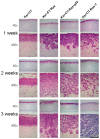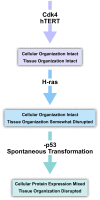H-ras expression in immortalized keratinocytes produces an invasive epithelium in cultured skin equivalents
- PMID: 19936293
- PMCID: PMC2774948
- DOI: 10.1371/journal.pone.0007908
H-ras expression in immortalized keratinocytes produces an invasive epithelium in cultured skin equivalents
Abstract
Background: Ras proteins affect both proliferation and expression of collagen-degrading enzymes, two important processes in cancer progression. Normal skin architecture is dependent both on the coordinated proliferation and stratification of keratinocytes, as well as the maintenance of a collagen-rich basement membrane. In the present studies we sought to determine whether expression of H-ras in skin keratinocytes would affect these parameters during the establishment and maintenance of an in vitro skin equivalent.
Methodology/principal findings: Previously described cdk4 and hTERT immortalized foreskin keratinocytes were engineered to express ectopically introduced H-ras. Skin equivalents, composed of normal fibroblast-contracted collagen gels overlaid with keratinocytes (immortal or immortal expressing H-ras), were prepared and incubated for 3 weeks. Harvested tissues were processed and sectioned for histology and antibody staining. Antigens specific to differentiation (involucrin, keratin-14, p63), basement-membrane formation (collagen IV, laminin-5), and epithelial to mesenchymal transition (EMT; e-cadherin, vimentin) were studied. Results showed that H-ras keratinocytes produced an invasive, disorganized epithelium most apparent in the lower strata while immortalized keratinocytes fully stratified without invasive properties. The superficial strata retained morphologically normal characteristics. Vimentin and p63 co-localization increased with H-ras overexpression, similar to basal wound-healing keratinocytes. In contrast, the cdk4 and hTERT immortalized keratinocytes differentiated similarly to normal unimmortalized keratinocytes.
Conclusions/significance: The use of isogenic derivatives of stable immortalized keratinocytes with specified genetic alterations may be helpful in developing more robust in vitro models of cancer progression.
Conflict of interest statement
Figures









Similar articles
-
Development of a Full-Thickness Human Gingiva Equivalent Constructed from Immortalized Keratinocytes and Fibroblasts.Tissue Eng Part C Methods. 2016 Aug;22(8):781-91. doi: 10.1089/ten.TEC.2016.0066. Tissue Eng Part C Methods. 2016. PMID: 27406216 Free PMC article.
-
The basement membrane microenvironment directs the normalization and survival of bioengineered human skin equivalents.Matrix Biol. 2008 Apr;27(3):163-70. doi: 10.1016/j.matbio.2007.09.002. Epub 2007 Sep 22. Matrix Biol. 2008. PMID: 18029161 Free PMC article.
-
Discrimination of epithelium-like and fibroblast-like phenotypes derived from ethanol-treated immortalised human gingival keratinocytes in epithelial equivalents.Cell Tissue Res. 2008 Apr;332(1):57-71. doi: 10.1007/s00441-007-0551-y. Epub 2008 Jan 10. Cell Tissue Res. 2008. PMID: 18188601
-
Roles of E- and P-cadherin in the human skin.Microsc Res Tech. 1997 Aug 15;38(4):343-52. doi: 10.1002/(SICI)1097-0029(19970815)38:4<343::AID-JEMT2>3.0.CO;2-K. Microsc Res Tech. 1997. PMID: 9297684 Review.
-
Alterations in epidermal biochemistry as a consequence of stage-specific genetic changes in skin carcinogenesis.Environ Health Perspect. 1991 Jun;93:3-10. doi: 10.1289/ehp.91933. Environ Health Perspect. 1991. PMID: 1773799 Free PMC article. Review.
Cited by
-
Bisphosphonates inhibit expression of p63 by oral keratinocytes.J Dent Res. 2011 Jul;90(7):894-9. doi: 10.1177/0022034511407918. Epub 2011 May 6. J Dent Res. 2011. PMID: 21551338 Free PMC article.
-
Keratin isoform shifts modulate motility signals during wound healing.bioRxiv [Preprint]. 2024 Apr 21:2023.05.04.538989. doi: 10.1101/2023.05.04.538989. bioRxiv. 2024. Update in: Dev Cell. 2024 Oct 21;59(20):2759-2771.e11. doi: 10.1016/j.devcel.2024.06.011. PMID: 37205459 Free PMC article. Updated. Preprint.
-
A novel role of RASSF9 in maintaining epidermal homeostasis.PLoS One. 2011 Mar 21;6(3):e17867. doi: 10.1371/journal.pone.0017867. PLoS One. 2011. PMID: 21445300 Free PMC article.
-
Prolonged overexpression of Wnt10b induces epidermal keratinocyte transformation through activating EGF pathway.Histochem Cell Biol. 2015 Sep;144(3):209-21. doi: 10.1007/s00418-015-1330-6. Epub 2015 May 21. Histochem Cell Biol. 2015. PMID: 25995040 Free PMC article.
-
Shifts in keratin isoform expression activate motility signals during wound healing.Dev Cell. 2024 Oct 21;59(20):2759-2771.e11. doi: 10.1016/j.devcel.2024.06.011. Epub 2024 Jul 12. Dev Cell. 2024. PMID: 39002537
References
-
- Thiery JP, Sleeman JP. Complex networks orchestrate epithelial-mesenchymal transitions. Nat Rev Mol Cell Biol. 2006;7:131–142. - PubMed
-
- Guarino M. Epithelial-mesenchymal transition and tumor invasion. Int J Biochem Cell Biol. 2007;39:2153–2160. - PubMed
-
- Ridky TW, Khavari PA. Pathways sufficient to induce epidermal carcinogenesis. Cell Cycle. 2004;3:621–624. - PubMed
-
- Wennerberg K, Rossman KL, Der CJ. The Ras superfamily at a glance. J Cell Sci. 2005;118:843–846. - PubMed
-
- Shields JM, Pruitt K, McFall A, Shaub A, Der CJ. Understanding Ras: ‘it ain't over 'til it's over’. Trends Cell Biol. 2000;10:147–154. - PubMed
Publication types
MeSH terms
Substances
Grants and funding
LinkOut - more resources
Full Text Sources
Research Materials
Miscellaneous

